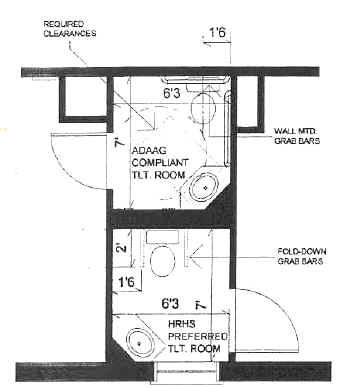Best Practices in the Design of Toileting and Bathing Facilities for Assisted Transfers
Conclusions and Recommendations
Findings of this project were as discouraging as they were encouraging. On the encouraging side, most participants had a good understanding of the problems that older individuals and caregivers face with accessibility to toileting and bathing facilities. Moreover, the best practice designs reflect this understanding and are attempts to address the problems. On the discouraging side, the solutions are too few and some of those don’t go far enough. It appears that too often the solution was "when in doubt, comply with ADAAG". However, this was not because designers and facility owners did not want to push the envelope, but rather because of their limited ability to do so. The reasons for this are twofold.
First, achievement of innovation under equivalent facilitation is difficult. Too often innovation and alternative designs that will meet the needs of frail individuals, but that do not meet ADAAG specifications, are rejected by local officials who generally don’t understand the intent of the ADA as well as they do enforcement of it. As a result, even when designs (such as OWP&P’s bathroom-as-shower-room) are equivalent (or in some cases superior) for a frail, older population, ADAAG-compliant solutions are still required by local codes officials. Fortunately, innovations occur despite the system when a building owner is willing to pay for what is needed in addition to what is required. The most obvious example was found at Holy Redeemer Health System in Meadowbrook, PA (Ewing Cole Cherry Brott) where two types of toilet rooms were constructed - an ADAAG compliant toilet room to appease building code officials and a "preferred" toilet room that was not ADAAG compliant, but better met the needs of users (Figure 17).

Figure 17. Toilet Rooms at Holy Redeemer Health System, Meadowbrook, PA (Ewing Cole Cherry Brott)
Second, there is too little research information available to guide and set precedence for innovative design decisions. Even when designers intuitively believe that ADAAG specifications are not appropriate for older individuals, they don’t have data to suggest what the appropriate solutions would be. Thus, in the absence of data, designers end up using ADAAG specifications, but push its limits as much as possible (e.g., high toilets and low grab bars).
RECOMMENDATIONS
Based on the conclusions above, two avenues of attack are recommended. First, research is needed to understand the impact of design on caregivers and care recipients as well to develop design specifications for older adults. The former includes the impact of current guidelines and alternative designs on: safety and injury prevention; proper positioning of care recipients and care providers; stress reduction, especially among dementia patients; and flexibility in accommodating individuals with different abilities. The latter includes studies to determine optimum design specifications, such as: toilet height and location, grab bar height, positioning, and location; clear floor space; and size of fixtures.
Second, in the absence of any better information, it is recommended that a number of immediate changes be implemented to ADAAG to better accommodate assisted transfers in facilities used predominantly by older adults.
-
Provide a minimum 24" clearance between any obstruction (e.g., sidewall) and the side of the toilet seat.
-
Permit rear or floor mounted swing-away grab bars on both sides of the toilet.
-
Accommodate non-standard bathtubs such as the Kohler Precedence tub by permitting a single horizontal grab bar.
-
Permit swing away grab bars in and adjacent to tubs and showers to add flexibility.
-
Finally, even though orientation of toilet rooms do not directly impact transfer, toilet room designs that minimize turning radii (e.g., doors on 450 angles) should be encouraged to facilitate access.

User Comments/Questions
Add Comment/Question